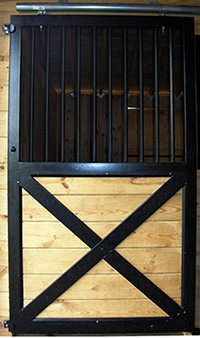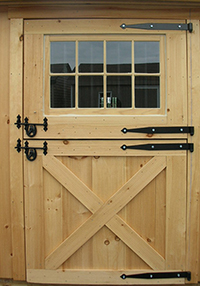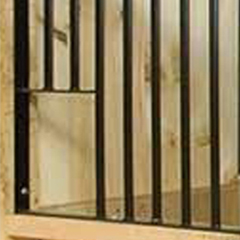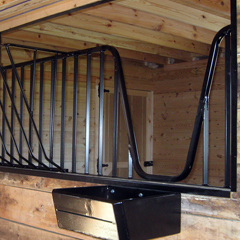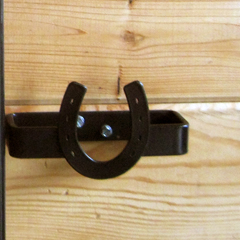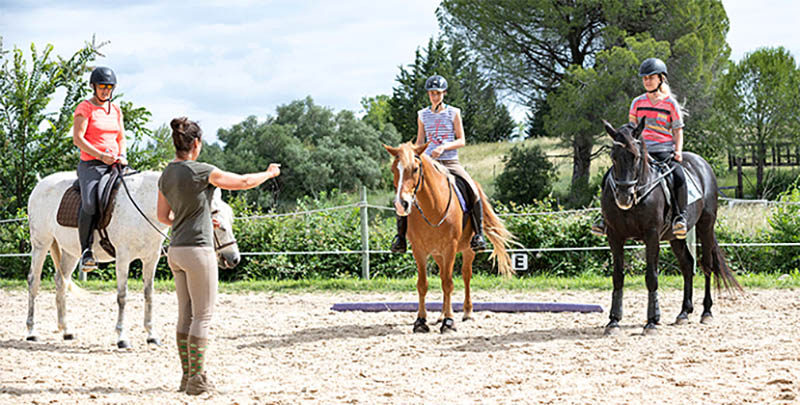
The “Humble” Stall Door
Think about it… a horse stall door is not such a simple thing. In fact, it is probably the most used piece of barn equipment you have! Therefore, it’s definitely worth spending some time making the right choices and look at all your barn options to ensure your stall doors will be functional, safe, and something you’ll be happy to use for many years to come.
A simple and often overlooked component of any barn, the stall door is an integral part of its construction and functionality. The horse stall door, in conjunction with the stall front, greatly contributes to a barn’s safety and ease of use. We’ll begin this examination with some definitions concerning size and type, followed by a few comments on style, and finally a couple options you might want to consider.
There are two main types of barn stall doors: the hinged door and the sliding door. However, the size and durability requirements are the same for both. Stall doors should be at least 4’ wide and 7’ high. This is a comfortable size for practically all horses.
Hint:
For a chronic pawer cut a rubber stall mat to the size of the lower half of the door and screw it onto the inside of the door.
It will help save the door and your horse’s feet
Stall doors get pawed and kicked, they are thrown open several times a day, and wheelbarrows or pitchforks frequently knock their frames. In short, horse stall doors take a lot of abuse, and construction is an important issue for safety and longevity. All metal pieces (hinges, latches, tracks, etc.) should ideally be powder-coated or galvanized steel. Wood should be thick and reinforced with an “X” or other type of bracing. Make sure the door and all of its components are built for the intended purpose and will be sturdy enough to provide years of service.

The most common type of hinged door on horse barns is the”Dutch” style door. This barn stall door is split in half horizontally to allow the top half to be opened independently of the bottom. This feature increases ventilation in the stall and barn, and allows the horses to stick their heads over the door for greater socialization. However, it also may pose a hazard if a horse decides to try to jump through it. This is rare, but you should be aware it can happen.
The split in a Dutch door (where the top and bottom pieces come together) is frequently cut on an angle , slanting down towards the outside. The reason for this is when the bottom half is opened, it pulls the top half along with it eliminating the need to pull both sections independently when opening or closing the door. A latch, to secure the two pieces together, is also a good idea to prevent the top half swinging closed and hitting a horse (or a human!) in the head.
There are two features to consider if an exterior Dutch barn door is to be practical. The first is a chew guard. This is a piece of heavy metal that fits over the top edge of the bottom door. The chew guard discourages horses from chewing or cribbing on the convenient ledge created when the top of the door is open. Such behavior not only damages the wood but also your horse’s teeth.
A second important feature of an exterior Dutch barn door is some type of mechanism on the outside of the door to enable it to be secured in the “open” position. This could be as simple as a hook and eye latch. The hook on the horse stall door connects to an eye on the barn wall. Install one for each half – top and bottom – of the Dutch door. Some latch hardware comes with it’s own specialized clasp (that you mount on the barn wall) to “catch” the latch and hold the door section in the “open” position.
Dutch doors are usually exterior doors and it is common practice to put them on an outside stall wall in an aisle barn in place of (or in addition to) a window. Besides allowing more light natural light and fresh air into the barn, it provides an another way out of the stall in the case of fire, as well as giving a horse free access to the stall from an attached pasture or paddock.
A Sliding door is another stall door option. This type of door usually has a wood bottom section and metal bars (grill) in the top half. Due to their openness, this type of door is most frequently used inside the barn to access the stall from the aisle. Sliding doors (with grills) may also be used as exterior doors in very warm climates. Or, they may be made as a solid wood door for exterior use in cooler climates. The sliding door is easy to operate and doesn’t require as much clearance as a hinged door when opening. It consists of the door panel, a track (for the wheels or rollers) at the top, a latch, and stops or guides at the bottom.
There should be at least two guides (located outside and at the bottom of the stall front wall) for the door. The first is an “L” shaped bracket at the lower outer corner to stop the door as it closes and keep the bottom of the door from coming away from the wall thus preventing a hoof getting caught between the door and the wall. The second is a “U” shaped bracket that is set open end up at the other bottom corner of the door. This guides the door in the track and also prevents it from being pushed too far away from the wall. There may be a ball on this bracket to enhance sliding. A third bracket may be present, at the end of the track, to stop the door when it slides open.
The sliding horse stall door is available a variety of styles. As previously mentioned, the most common is a wood bottom and grill top. You may choose to put a “V” yoke in the grill part of the horse stall door. This allows the horses to hang their heads out and socialize. Bear in mind, the possibility always exists that a horse could get a leg through these yokes. Know your horse’s temperament and habits and choose a door that keeps him (and you) safe!
Some sliding door grills may incorporate a hinged section of bars. This section can be opened to hang down flat against the door so horses can stick their heads out or for an owner’s ease in feeding. A hinged grill section of this type gives you the option of keeping the opening closed if you have an ornery or mouthy horse in your barn.
Yet another choice is to have the horse stall door made completely of steel mesh, with or without a yoke. This increases ventilation even more and allows you a greater view of the stall interior. Another advantage to a door of this type is that smaller horses, ponies and minis can see what’s going on in the barn. Mesh doors can be installed on both the inside and outside of the barn (depending on climate) to allow extra light and fresh air into the barn. However, one drawback would be that pawing or rolling horses might kick shavings through the door and into a freshly swept aisle.
On a solid wood sliding door or on a Dutch door, you may wish to have a window put in the top. It is wise to make sure there is a heavy duty grill over the inside of the window to prevent a horse from kicking it out. A grill on the outside may be necessary as well if horses have free access right outside the barn.
Beyond the stall door, there are some options that you may wish to consider adding to the stall front. One of these is a feed-through cut-out. A section of the stall front bars (or grill) – just large enough for a grain scoop or can to fit through – is left open. A feed or water bucket hung just below this opening makes feeding/watering time quicker and easier. You no longer need to open the door and push back your eager horse to give him his dinner. Just drop the feed through the cut-out and move on to the next horse. If you want a cut-out on a shed row barn, where the stall front is actually the exterior wall of the building, it can be made as a little door.
Hayracks may also be put in the grill stall front to facilitate the feeding of hay. A bridle hook and/or a blanket rack is a last addition that increases convenience and, depending on design, may even serve as sliding door stops as well.
As you can see, there’s much more to a stall door then first meets the eye. Horizon Structures offers all the choices and variation you need to make the right choice for your stall doors. Check out the options on our 2 stall horse barn today.
Feed-thru cut out
Stall front wall with hayrack and “V” yoke
Bridle hook as door stop


